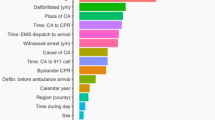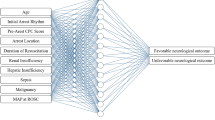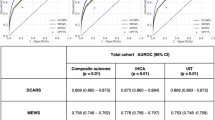Abstract
The purpose of this study is to use ensembled neural networks (ENN) to model survival rate for the patients with out-of-hospital cardiac arrest (OHCA). We also use seven different sensitivity analyses to find out the important variables to establish a comprehensive and objective assessment method for the OHCA patients. After pre-filtering, we obtained 4,095 data for building this ENN model. The data have been divided into 60 % data for training, 20 % data for validation, and 20 % data for testing. The 11 inputs, including response time, on-scene time, patient transfer time, time to cardiopulmonary resuscitation (CPR), CPR on the scene, using drugs, age, gender, using airway, using automated external defibrillator (AED), and trauma type, and one output variable have been selected as ENN model structure. The results have been shown that ENN can model the OHCA patients and CPR on the scene, using drugs, on-scene time, and using airway in the top 4 of these 11 important variables after 7 different sensitivity analyses. Moreover, these four variables have also been shown significant differences when we use traditional one variable statistics analysis for these variables.

Similar content being viewed by others
Explore related subjects
Discover the latest articles, news and stories from top researchers in related subjects.References
Abbod MF, Cheng KY, Cui XR, Huang SJ, Han YY, Shieh JS (2011) Ensembled neural networks for brain death prediction for patients with severe head injury. Biomed Signal Process Control 6:414–421
Liu Q, Cui XR, Abbod MF, Huang SJ, Han YY, Shieh JS (2011) Brain death prediction based on ensembled artificial neural networks in neurosurgical intensive care unit. J Taiwan Inst Chem Eng 42(1):97–107
Spaite DW, Valenzuela TD, Meislin HW, Criss EA, Hinsberg P (1993) Prospective validation of a new model for evaluating emergency medical services systems by in-field observation of specific time intervals in prehospital care. Ann Emerg Med 22(4):638–645
Ramanujiam P, Castillo E, Patel E, Vilke G, Wilson MP, Dunford JV (2009) Pre-hospital transport time interval for acute stroke patients. J Emerg Med 37(1):40–45
Balady GJ, Chaitman B, Foster C, Froelicher E, Gordon N, Van Camp S (2002) Automated external defibrillators in health/fitness facilities supplement to the AHA/ACSM Recommendations for Cardiovascular Screening, Staffing, and Emergency Policies at Health/Fitness Facilities. Circulation 105(9):1147–1150
White DA, Sofge DA (1992) Handbook of intelligent control: Neural, Fuzzy, and Adaptive Approaches. Van Nostrand Reinhold, New York
Upegui A, Sanchez E (2005) An FPGA platform for on-line topology exploration of spiking neural networks. Microprocess Microsyst 29(5):211–223
Hansen LK, Salamon P (1990) Neural Network Ensemble. IEEE Trans Pattern Anal Mach Intell 12(10):993–1001
Krogh A, Vedelsby J (1995) Neural network ensembles, cross validation, and active learning. In: Tesauro G, Touretzkey D, Leen T (eds) Advances in Neural Information Processing Systems, 7. MIT Press, Cambridge, pp 231–238
Francos A, Elorza FJ, Bouraoui F, Bidoglio G, Galbiati L (2003) Sensitivity analysis of distributed environmental simulation models: understanding the model behaviour in hydrological studies at the catchment scale. Reliab Eng Syst Saf 79(2):205–218
Zador J, Zsely IG, Turanyi T (2006) Local and global uncertainty analysis of complex chemical kinetic systems. Reliab Eng Syst Saf 91(10):1232–1240
Gevrey M, Dimopoulos I, Lek S (2003) Review and comparison of methods to study the contribution of variables in artificial neural network models. Ecol Model 160:249–264
Scardi M, Harding LW (1999) Developing an empirical model of phytoplankton primary production: a neural network case study. Ecol Model 120:213–223
Olden JD, Jackson DA (2002) Illuminating the “black box”:understanding variable contributions in artificial neural networks. Ecol Model 154:135–150
Garson GD (1991) Interpreting neural-network connection weights. Artif Intell Expert 6:47–51
Cui XR, Abbod MF, Liu Q, Shieh JS, Chao TY, Hsieh CY, Yang YC (2011) Ensembled artificial neural networks to predict the fitness score for body composition analysis. J Nutr Health Aging 15(5):341–348
Acknowledgments
The authors wish to thank the National Science Council (NSC) of Taiwan (Grant Number NSC 99-2221-E-155-046-MY3) and the Center for Dynamical Biomarkers and Translational Medicine, National Central University, Taiwan (Grant Number: NSC 100-2911-I-008-001) for supporting this research.
Author information
Authors and Affiliations
Corresponding author
About this article
Cite this article
Jiang, YJ., Ma, M.HM., Sun, WZ. et al. Ensembled neural networks applied to modeling survival rate for the patients with out-of-hospital cardiac arrest. Artif Life Robotics 17, 241–244 (2012). https://doi.org/10.1007/s10015-012-0048-y
Received:
Accepted:
Published:
Issue Date:
DOI: https://doi.org/10.1007/s10015-012-0048-y




